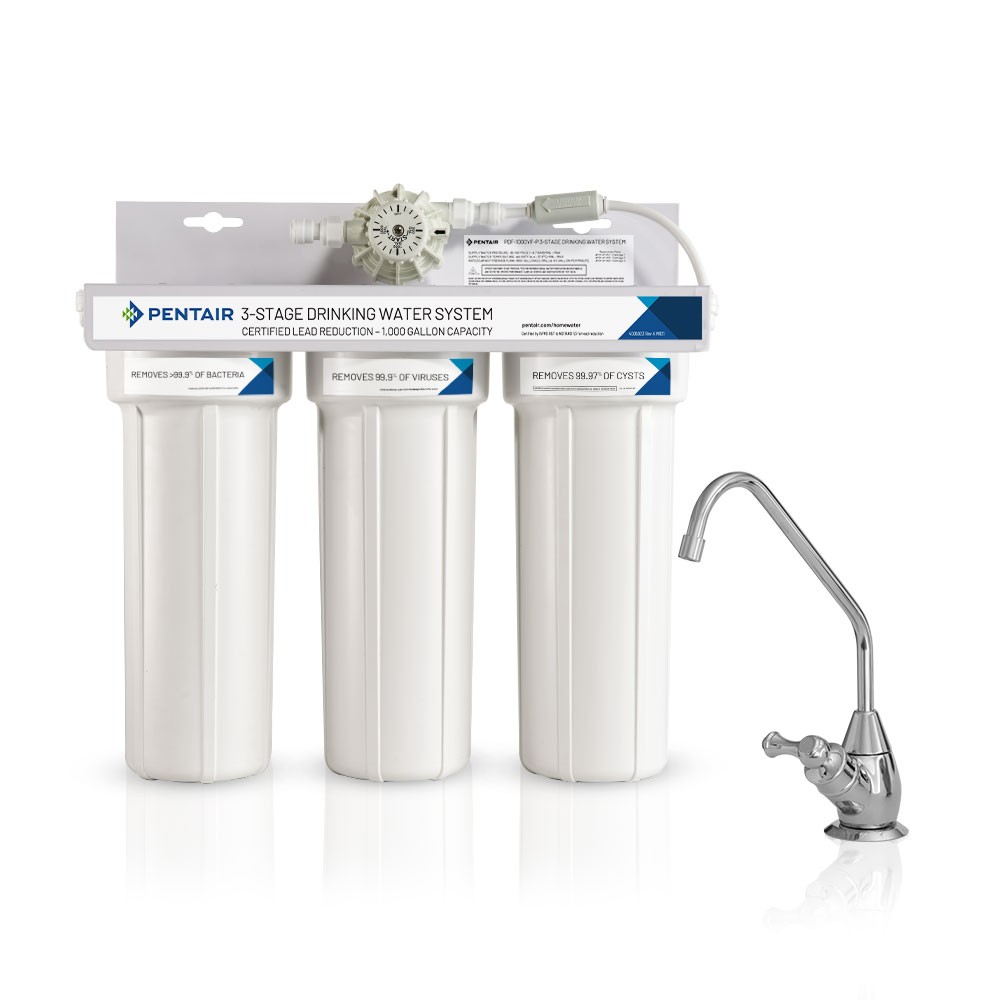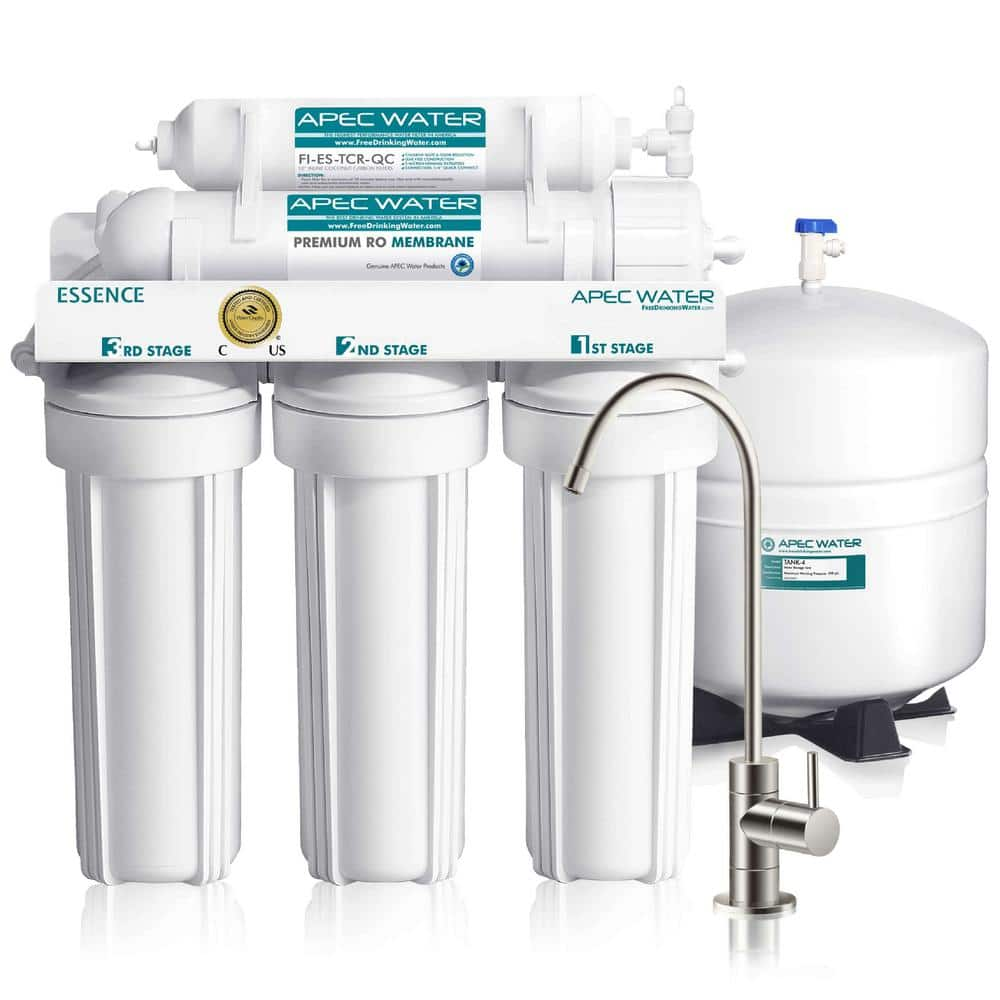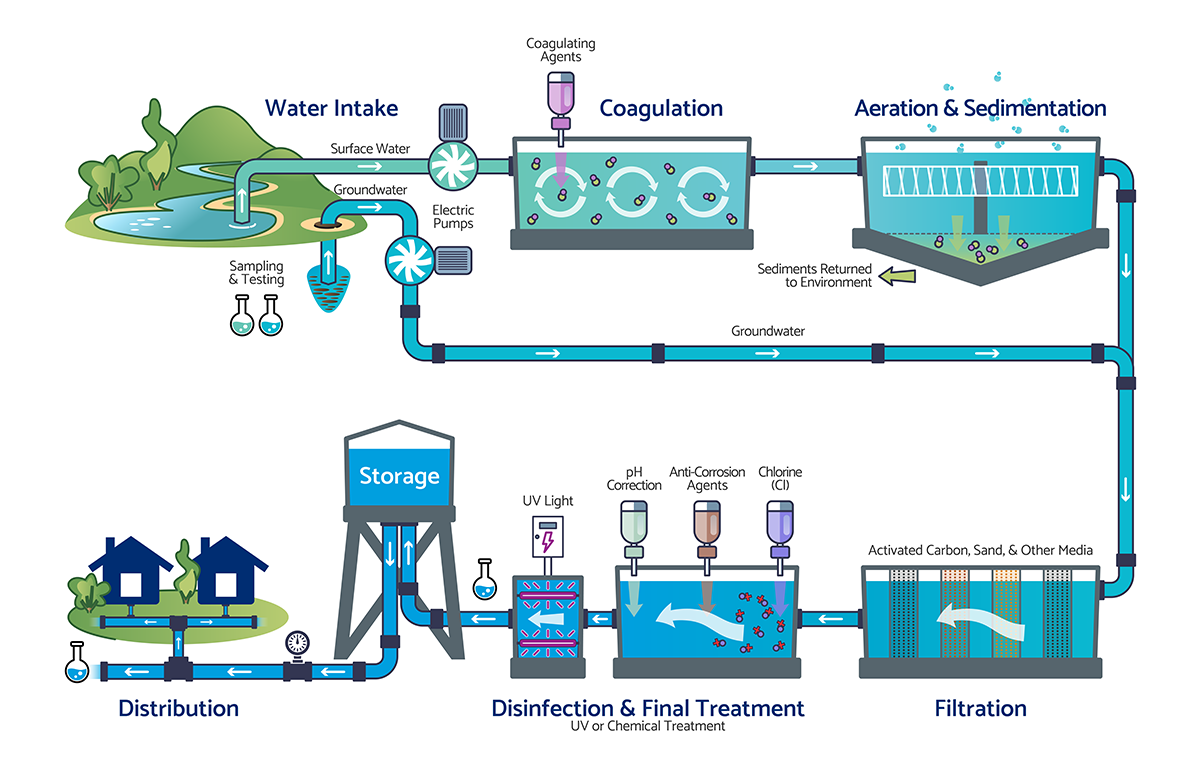Common Contaminants In Tap Water And Unexpected Risks
Rounding out the lineup of threats are microbes—E. coli, giardia, cryptosporidium—stowaways that can slip through if treatment lags or distribution lines break. After heavy rains or infrastructure failures, these pathogens can surge, causing gastrointestinal distress or worse. Critical infrastructure resilience experts underline that even a brief system compromise can expose entire communities [3]. And if that weren’t enough, the emerging spotlight on microplastics and pharmaceutical residues in tap water raises fresh questions: what else is eluding our filters until it’s already in our bodies? A 2022 review highlighted microplastics in over 80% of sampled municipal systems worldwide, pushing us to rethink “safe” standards [5].

Fortunately, we’re not powerless. Simple point-of-use filters—especially reverse osmosis water filtration—can strip out over 95% of lead, nitrates, and countless organic chemicals, transforming suspect tap drips into pure refreshment reverse osmosis water filtration. Routine testing—at least annually—helps catch anomalies before they become headaches. I once tested my own kitchen faucet and was relieved to find nitrates well below concern levels, a small victory that reinforced the value of vigilance. Have you ever paused to wonder what’s in your glass? It’s a quick step that brings huge peace of mind.
Sources Of Drinking Water And Their Impact On Tap Safety
Every community’s water journey starts with its source. Surface water—drawn from lakes, rivers, or reservoirs—is accessible but often burdened with sediments, agricultural run-off, and urban pollutants. Groundwater, pumped from wells and aquifers, filters naturally through rock and soil, picking up minerals like calcium and iron along the way. That subterranean journey can lend water a pleasant mouthfeel, but it also channels nitrates and arsenic in regions with intensive farming or naturally occurring deposits [4]. Each choice—surface versus ground—sets the stage for your tap’s flavor, clarity, and safety.
Surface supplies demand rigorous treatment: coagulants to clump sediments, sedimentation basins to let particles settle, and filtration or UV steps to neutralize pathogens. Yet even sophisticated plants can’t anticipate every storm-driven pollutant surge. Groundwater systems often skip heavy sediment treatment but require vigilant monitoring for dissolved minerals and potential contaminants from septic systems. In both cases, distribution pipelines—if aged or poorly maintained—pose their own hazards, leaching metals or allowing microbial intrusions after pipe breaches [1]. It’s a vast, hidden network whose integrity we usually take for granted until whispers of boil-water advisories pop up on local news.

For private well owners, the equation shifts entirely. Without municipal safeguards, your water’s journey from aquifer to tap is unregulated. Installing a robust well water filtration system and testing for common rural concerns—nitrates, coliform bacteria, heavy metals—becomes essential. Meanwhile, city dwellers grappling with a lingering chlorine taste can supplement with under-sink filters or point-of-use reverse osmosis units. Ultimately, understanding your source’s quirks is the first step in crafting a defense that fits your home’s unique water story.
Filtration Vs Treatment Processes
In the world of water purification, filtration and treatment are cousins with distinct roles. Filtration physically traps particles—from rust flakes and sand grains down to microscopic sediments—using layers of media or membranes. Treatment, by contrast, neutralizes threats at a molecular level: chlorine kills bacteria, UV lamps deactivate viruses, and ozone oxidizes organic chemicals. Both approaches are vital; blending them yields the purest, safest water.
Here’s a quick comparison:
| Method | Primary Function | Typical Removes | Considerations |
|---|---|---|---|
| Sediment Filtration | Physical barrier | Sand, rust, particulate matter | Requires regular backwashing or filter swaps |
| Activated Carbon | Adsorption of organics | Chlorine taste, VOCs, odors | Filter life varies by contaminant load |
| Reverse Osmosis | High-pressure membrane | Dissolved solids, heavy metals, nitrates | Produces wastewater; may strip beneficial minerals |
| UV Disinfection | Light inactivation | Bacteria, viruses, protozoa | No residual protection; requires clear water |
Chemical treatment—chlorination or chloramination—remains the backbone of municipal systems thanks to its lingering disinfection effect, but it can spawn byproducts that worry health experts [2]. Alternatives like ozone or UV lamps sidestep those byproducts yet lack the persistent safeguard chlorine offers. I often advise a layered strategy: start with physical filtration to strip sediments and organics, then add a targeted treatment step—UV or carbon—tailored to your water’s weaknesses. That approach mirrors best practices in critical infrastructure resilience, where redundancy is key to weathering surprises [3].
Choosing the Right Water Filtration System
Picking the perfect filter feels like detective work: you need to know what lurks in your tap before zeroing in on a solution. Start with a detailed water test—check for hardness, chlorine levels, pH balance, microbial presence, and any heavy metals flagged in your region’s water quality report. From there, decide between a whole-house setup and a point-of-use device. A whole-house filter and softener combo treats every drop entering your home, safeguarding plumbing fixtures and skin from scale and chlorine irritants. Though upfront costs can run high, many homeowners view it as a lasting safeguard against maintenance headaches and dry hair whole-house filter and softener combo.
On the flip side, point-of-use units—compact under-sink or countertop filters—hone in on drinking and cooking taps, delivering ultra-pure water right where you need it most. Reverse osmosis systems dominate this category, stripping lead, fluoride, and chlorine with precision. They cost less upfront but demand more frequent filter swaps and only cover specific faucets. For a small family with limited space, these units can be a real game-changer: crisp ice cubes, flavorful coffee, and juice that sings.

Balancing budget, installation complexity, and coverage area is crucial. If you’re renovating, consider plumbing layouts and space for tanks or UV chambers. If you rent, a sleek countertop or faucet-mounted filter might be the only practical choice. In all cases, match the technology to your water’s quirks, and you’ll toast to better hydration every day.
DIY Water Filtration Installation Tips And When To Call A Pro
Rolling up your sleeves to install an under-sink filter can be empowering—and cost-effective—if you follow a few simple steps. Always begin by testing your water to pinpoint specific issues: is it chlorine taste, sediment, or hardness? Armed with that insight, choose a system designed to tackle those exact concerns. Next, shut off the cold-water valve and open the faucet to relieve pressure. Lay down a towel or shallow basin beneath the area to catch drips. Carefully measure your cabinet space to ensure the filter housing and cartridges fit snugly.
When mounting the bracket or filter head, use a level to keep everything straight. Secure tubing with compression fittings—no glue needed—and wrap plumber’s tape around threaded connections to ward off leaks. Once the cartridges are in place, slowly restore water pressure and meticulously inspect each joint. A properly sealed system can eliminate up to 99% of bacteria and particulates, but even the slightest drip can undermine performance [5]. Swapping filters every six to twelve months and rinsing O-rings with a mild bleach solution keeps things flowing smoothly.
However, some scenarios merit a professional’s touch. Complex plumbing layouts with manifold valves or tight crawl spaces can quickly turn a DIY job into a headache—and a hidden leak can compromise your entire home’s water delivery. If you’re eyeing a whole-house system, an expert can correctly size pumps and tanks to meet peak demand without sacrificing pressure. Consulting a licensed plumber not only ensures code compliance but gives you peace of mind, knowing your water network—an extension of critical municipal infrastructure—is in safe hands [3].
The Role Of Minerals In Drinking Water
Natural minerals—calcium, magnesium, potassium—imbue tap water with character and benefits beyond mere hydration. As water weaves through subterranean rock layers, it dissolves trace elements that lend a silky texture to hard water or a notably flat taste to softer supplies. This regional fingerprint explains why some communities rave about “pure spring-like” flavor while others reach for pitchers to soften the bite.
Beyond palate perks, these minerals play active roles in human health: calcium supports bone density, magnesium regulates muscle and nerve function, and potassium helps maintain blood pressure. The EPA notes moderate water hardness poses no known health risks and can even enhance palatability, encouraging adequate fluid intake [2]. Yet the very systems that remove contaminants—like reverse osmosis—often strip these goodies away, leaving water that tastes neutral but may lack those subtle health boosts.
To restore mineral balance, many homeowners turn to remineralization filters or alkaline filter systems that reintroduce calcium and magnesium. A water ionizer home use device can adjust pH while adding minerals back in, creating a fuller mouthfeel and potentially enhancing antioxidant properties. Personally, after testing remineralized water side-by-side with flat RO output, I couldn’t go back—there’s a satisfying roundness that just feels right.
Integrating IoT In Water Systems
Today’s water infrastructure is undergoing a digital renaissance. Sensors embedded across treatment plants and distribution lines measure pH, turbidity, and pressure in real time, flagging issues before they escalate. Early results from pilot programs show contamination alerts dropping by up to 30%, as utilities can respond instantly to anomalies [3]. Likewise, remote monitoring dashboards give operators a bird’s-eye view of network health, streamlining maintenance and safeguarding public health.
At home, IoT has transformed humble filters into smart guardians. Under-sink units now pair with smartphone apps, notifying you when sediment levels rise or cartridges near their end-of-life. No more guesswork—just a gentle ping reminding you to swap that filter. A recent EPA survey found nearly half of homeowners crave these remote alerts, translating an invisible threat into actionable insights delivered straight to your pocket [2].
Personally, I felt a surge of relief the first time my smart meter buzzed to confirm lead levels were within safe limits—no more late-night “what if” worries. Families can even share water-use stats with neighbors or track seasonal shifts in fluoride levels using linked analytics. As cities expand these networks into broader smart-city frameworks, our water systems will interlace with energy and traffic grids, forging a resilient, responsive ecosystem where leaks vanish in minutes and contamination scares become relics of the past.
Tips And Best Practices For Maintaining Water Filtration Systems
Keeping your water filter in top form is the secret behind every satisfying sip. First, honor the manufacturer’s cartridge-replacement schedule—typically every three to six months for sediment and carbon filters, and annually for RO membranes. Stale cartridges not only reduce flow but can harbor trapped bacteria, undoing all your purification efforts [2].
Monthly checks work wonders: rinse or replace pre-filters, lightly sanitize O-rings with a diluted bleach solution, and inspect tubing for kinks or discoloration. If you spot any pressure dips or cloudy output, run a quick TDS test or schedule a microbiological analysis to nip hidden issues in the bud [5]. For whole-house systems, protect external components from freezing by insulating exposed pipes and store tanks. An annual professional tune-up—complete with system flush and safety inspection—ensures every valve, pump, and filter housing remains leak-proof, supporting the broader water network’s resilience [3].
Sustainable Innovations In Water Systems
The shift toward sustainability is reshaping water infrastructure worldwide. From solar-powered pumping stations to smart leak detectors that alert municipalities the moment a pipe sprouts a drip, technology is driving efficiency and resilience. Engineers rely on data from distribution sensors to fine-tune pressure and balance flows, minimizing energy consumption and reducing non-revenue water losses—efforts grounded in best practices around water distribution reliability [1].
Treatment innovations are equally exciting. Ultraviolet LEDs now deliver the germ-killing power of traditional UV systems but with lower energy demands and no hazardous mercury. Advanced membranes cut chemical use dramatically, removing over 99% of pathogens while generating less brine waste [5]. Community-scale rainwater harvesting and constructed wetlands offer decentralized solutions, slashing freshwater demand by as much as 30% in pilot projects [2].
I’m continually inspired by neighbors who’ve installed salt-free water conditioners to protect pipes without dumping sodium into local streams. These template-assisted crystallization systems lock minerals into inert crystals that won’t adhere to plumbing, safeguarding ecosystems and human health salt-free water conditioners. When communities embrace these green practices, they not only conserve precious resources but also weave water stewardship into daily life.
Summary Of Key Points
Our journey from source to sip is intricate, involving surface reservoirs, hidden aquifers, treatment plants, and miles of distribution pipes. Each stage—filtration for particles, chemical or UV treatment for microbes, and remineralization for taste—plays a vital role in delivering water that’s both safe and satisfying. Regulations under the Safe Drinking Water Act and modern digital controls guard public health, but proactive home solutions—from reverse osmosis water filtration to whole-house filter and softener combos—offer that extra layer of confidence.
Understanding the minerals that give water body, adopting smart IoT monitoring, and maintaining your system with regular checks ensures every glass you pour is an act of empowerment. It’s a ritual that transforms a mundane routine into a moment of mindful care—a toast to health, resilience, and the quietly remarkable journey of water through our lives.
Citations
“`html
Complete Top Picks Comparison – 20 Products
| Product | Source | Price | Rating | Image | Buy |
|---|---|---|---|---|---|
| APEC Water Systems ROES-50 Essence Series Top Tier 5-Stage WQA Certified Ultra Safe Reverse Osmosis Drinking Water Filter System | Amazon | $199.95 | ★★★★★☆☆☆☆☆ |  | Buy on Amazon |
| Waterdrop 10UA Under Sink Water Filter System, Reduces PFAS, PFOA/PFOS, Lead, Chlorine, Bad Taste & Odor, Under Counter Water Filter Direct Connect to Kitchen Faucet, NSF/ANSI 42 Certified, 8K Gallons | Amazon | $51.99 | ★★★★★☆☆☆☆☆ |  | Buy on Amazon |
| Culligan WH-S200-C Whole-House Sediment Water Filtration System, Clear | Amazon | $45.23 | ★★★★★☆☆☆☆☆ |  | Buy on Amazon |
| Big Berkey Gravity-Fed Stainless Steel Countertop Water Filter System 2.25 Gallon with 2 Authentic Black Berkey Elements BB9-2 Filters | Amazon | $367.00 | ★★★★★☆☆☆☆☆ |  | Buy on Amazon |
| GE GXWH20T Whole House Water Filtration System | Reduce Sediment, Rust & More | Install Kit & Accessories Included | Filter Not Included | Replace Filter (FXWTC, FXUSC, FXWPC, FXWSC) Every 3 Months | Amazon | $39.86 | ★★★★☆☆☆☆☆☆ |  | Buy on Amazon |
| iSpring US31 Classic 3-Stage Under Sink Water Filtration System for Drinking, Tankless, High Capacity, Sediment + GAC + Carbon | Amazon | $119.99 | ★★★★★☆☆☆☆☆ |  | Buy on Amazon |
| iSpring RCC7AK, NSF Certified, 75 GPD, Alkaline 6-Stage Reverse Osmosis System, pH+ Remineralization RO Water Filter System Under Sink, Patented Top-Mounted Faucet Design for Easy Installation | Amazon | $234.99 | ★★★★★☆☆☆☆☆ |  | Buy on Amazon |
| Culligan WH-HD200-C Whole House Water Filter System 1” Inlet/Outlet – Improve Tap Water Taste, Remove Sediment, Protect Appliances | Amazon | $71.20 | ★★★★☆☆☆☆☆☆ |  | Buy on Amazon |
| SimPure Whole House Water Big Filter Housing (DB10C), 10″ x 4.5″, Blue for Whole Home Water Filtration, Sediment Water Filter System for Well, 1″ NPT Brass Port (Clear Housing) | Amazon | $59.99 | ★★★★☆☆☆☆☆☆ |  | Buy on Amazon |
| Culligan HF-360A Standard Duty 3/4″ Inlet/Outlet Whole House Filtration System, Clear | Amazon | $37.49 | ★★★★★☆☆☆☆☆ |  | Buy on Amazon |
| Volantex New Spitfire RC Plane EPP 400mm Wingspan RC Fighter One Key Aerobatic 2.4G 4CH RTF Warbird Plane | AliExpress | $31.88 | N/A |  | Buy on AliExpress |
| JHD for JJRC C8818 Car 1:18 2.4G Pickup Remote Control Off road Climbing Vehicle 4WD RC Car Simulation Model Toy Gift | AliExpress | $31.80 | N/A |  | Buy on AliExpress |
| Rc Helicopter Remote Control Aircraft Airplane Men Children Toy Radio Flying Wireless Professional Goosky RS4 Venom Combo KIT | AliExpress | $156.03 | N/A |  | Buy on AliExpress |
| WLtoys 124019 1:12 4WD 55Km/H RC Racing Car Remote Control High Speed Off-Road Drift Shock Absorption Adults Boys Toys Kids Gift | AliExpress | $42.69 | N/A |  | Buy on AliExpress |
| Shengmilo MX06 city Electric Bike 1000W Urban Bicycle Fat bike electric 26″ E-bike 48V17.5AH Battery Adult E-mountainou bike | AliExpress | $327.69 | N/A |  | Buy on AliExpress |
| SCY 16101 16102 16103 PRO 4WD 1:16 RC Car Brushless Remote Control Car 70km/H 4×4 High Speed Floating RC Cars Toy Gift VS MJX | AliExpress | $28.29 | N/A |  | Buy on AliExpress |
| 16103 Fast Rc Cars 50km/h 1/16 Off Road 4WD with LED Headlights,2.4G Waterproof Remote Control Monster Truck for Adults and Kids | AliExpress | $31.88 | N/A |  | Buy on AliExpress |
| FMS RC Airplane 64mm Futura Tomahawk With Flaps Sport Trainer Ducted Fan EDF Jet 3 Color Model Hobby Plane Aircraft Avion PNP | AliExpress | $74.64 | N/A |  | Buy on AliExpress |
| Shengmilo MX06 city Electric Bike 1000W Urban Bicycle Fat bike electric 26″ E-bike 48V17.5AH Battery Adult E-mountainou bike | AliExpress | $327.69 | N/A |  | Buy on AliExpress |
| RC ERA C190 1:30 H145 Scale 2.4G 6CH 6-Axis Gyro Optical Flow Localization Altitude Hold Flybarless RC Helicopter RTF | AliExpress | $77.26 | N/A |  | Buy on AliExpress |
“`

